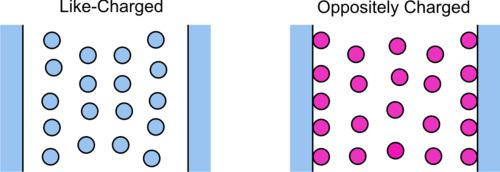Current Opinion in Colloid & Interface Science ( IF 7.9 ) Pub Date : 2021-06-29 , DOI: 10.1016/j.cocis.2021.101482 Liam R.J. Scarratt , Gregor Trefalt , Michal Borkovec

|
This article provides an overview of interactions between charged interfaces across concentrated suspensions of charged nanoparticles or solutions of polyelectrolytes. These systems bear many similarities. We distinguish the like-charged and oppositely charged situations. In the like-charged situation, a layered structure in the proximity of the interface is formed. This structure induces a strongly repulsive energy profile at shorter distances, which originates from a gap that is free of nanoparticles or polyelectrolytes. At larger distances, the profile becomes oscillatory. This energy profile can be quantified with a simple model, which distinguishes the near-field region and the far-field region. The parameters entering the model show characteristic scaling relations. In the oppositely charged situation, a saturated, tightly bound layer at the interface forms. This layer leads to a charge reversal of the interface and induces a similar layered structure as in the like-charged case.
中文翻译:

浓缩纳米颗粒悬浮液和聚电解质溶液界面之间的力
本文概述了带电纳米粒子的浓缩悬浮液或聚电解质溶液的带电界面之间的相互作用。这些系统有许多相似之处。我们区分电荷相同和电荷相反的情况。在同电荷情况下,在界面附近形成层状结构。这种结构在更短的距离内引起强烈的排斥能量分布,这源于没有纳米颗粒或聚电解质的间隙。在较大距离处,轮廓变得振荡。这种能量分布可以用一个简单的模型来量化,它区分了近场区域和远场区域。进入模型的参数显示了特征比例关系。在相反电荷的情况下,饱和,在界面形成紧密结合层。该层导致界面的电荷反转,并产生与类似电荷情况类似的层状结构。











































 京公网安备 11010802027423号
京公网安备 11010802027423号